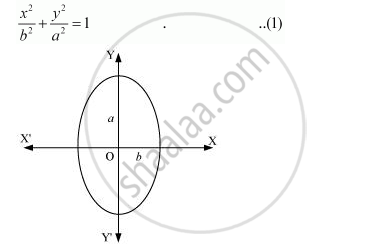Advertisements
Advertisements
Question
Form the differential equation of the family of ellipses having foci on y-axis and centre at origin.
Solution
The equation of the family of ellipses having foci on the y-axis and the centre at origin is as follows:


This is the required differential equation.
APPEARS IN
RELATED QUESTIONS
Form the differential equation of the family of circles touching the y-axis at the origin.
Form the differential equation of the family of hyperbolas having foci on x-axis and centre at origin.
Form the differential equation of the family of circles having centre on y-axis and radius 3 units.
Which of the following differential equations has y = c1 ex + c2 e–x as the general solution?
(A) `(d^2y)/(dx^2) + y = 0`
(B) `(d^2y)/(dx^2) - y = 0`
(C) `(d^2y)/(dx^2) + 1 = 0`
(D) `(d^2y)/(dx^2) - 1 = 0`
For the curve y = 5x – 2x3, if x increases at the rate of 2 units/sec, then find the rate of change of the slope of the curve when x = 3
Form the differential equation from the following primitive where constants are arbitrary:
xy = a2
Form the differential equation from the following primitive where constants are arbitrary:
y = ax2 + bx + c
Form the differential equation corresponding to y2 − 2ay + x2 = a2 by eliminating a.
Form the differential equation of the family of curves represented by the equation (a being the parameter):
(2x − a)2 − y2 = a2
Form the differential equation of the family of curves represented by the equation (a being the parameter):
(x − a)2 + 2y2 = a2
Represent the following families of curves by forming the corresponding differential equations (a, b being parameters):
y2 = 4ax
Represent the following families of curves by forming the corresponding differential equations (a, b being parameters):
x2 + (y − b)2 = 1
Represent the following families of curves by forming the corresponding differential equations (a, b being parameters):
y = ax3
Represent the following families of curves by forming the corresponding differential equations (a, b being parameters):
x2 + y2 = ax3
Represent the following families of curves by forming the corresponding differential equations (a, b being parameters):
y = eax
Find the equation of a curve passing through the point (0, 0) and whose differential equation is \[\frac{dy}{dx} = e^x \sin x\]
Find one-parameter families of solution curves of the following differential equation:-
\[\frac{dy}{dx} + 3y = e^{mx}\], m is a given real number.
Find one-parameter families of solution curves of the following differential equation:-
\[x\frac{dy}{dx} + y = x^4\]
Find one-parameter families of solution curves of the following differential equation:-
\[\frac{dy}{dx} - \frac{2xy}{1 + x^2} = x^2 + 2\]
Find one-parameter families of solution curves of the following differential equation:-
\[\frac{dy}{dx} \cos^2 x = \tan x - y\]
Find one-parameter families of solution curves of the following differential equation:-
\[e^{- y} \sec^2 y dy = dx + x dy\]
The differential equation which represents the family of curves y = eCx is
Form the differential equation of the family of ellipses having foci on y-axis and centre at the origin.
Form the differential equation representing the family of curves `y2 = m(a2 - x2) by eliminating the arbitrary constants 'm' and 'a'.
Form the differential equation representing the family of curves y = A sin x, by eliminating the arbitrary constant A.
Find the differential equation of the family of lines through the origin.
Find the equation of a curve passing through the point (1, 1) if the perpendicular distance of the origin from the normal at any point P(x, y) of the curve is equal to the distance of P from the x-axis.
Form the differential equation of all circles which pass through origin and whose centres lie on y-axis.
Form the differential equation by eliminating A and B in Ax2 + By2 = 1
Find the equation of a curve passing through origin if the slope of the tangent to the curve at any point (x, y) is equal to the square of the difference of the abcissa and ordinate of the point.
Find the equation of a curve passing through the point (1, 1). If the tangent drawn at any point P(x, y) on the curve meets the co-ordinate axes at A and B such that P is the mid-point of AB.
The differential equation `y ("d"y)/("d"x) + "c"` represents: ______.
The differential equation of the family of curves x2 + y2 – 2ay = 0, where a is arbitrary constant, is ______.
The differential equation representing the family of circles x2 + (y – a)2 = a2 will be of order two.
Differential equation representing the family of curves y = ex (Acosx + Bsinx) is `("d"^2y)/("d"x^2) - 2 ("d"y)/("d"x) + 2y` = 0
